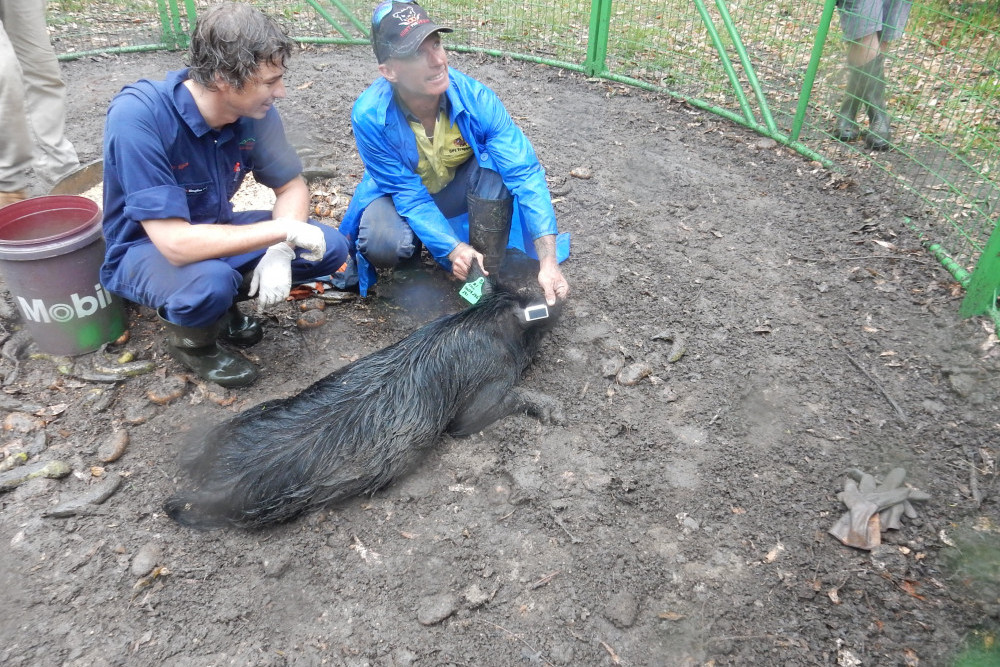On The Land
21 November, 2021
Feral pig project exposes porcine preferences
FAR North Queenslanders are about to learn a whole lot more about the habits and lifestyle of our 26 million strong feral pig population.

Feral pigs are a serious environmental and agricultural pest that destroy around $112 million worth of crops and pasture annually, as well as habitat for native plants and animals, through wallowing, rooting for food and selective feeding.
The Community Engagement project, which involves the trapping, tagging and monitoring of 10 feral pigs over a 12 to 24 month period, will be delivered by Graham Schoorl of "GPS Tracking," using highly sophisticated equipment.
Earlier this year, Mr Schoorl set up a trap site in the Baldy Mountain Forest Reserve at a site selected by the Queensland Parks and Wildlife Service (QPWS) Ranger-in Charge, Roger James.
A total of 15 pigs have already been caught there, and at sunrise on November 2, one animal was selected to tag.
Representatives from Barron Catchment Care (BCC), local landholders, QPWS, Tablelands Regional Council (TRC) and GPS Trapping, joined vet Ryan Cockrem as he sedated the pig and fitted it with a Ceres satellite ear tag.
The ear tags have a solarpowered screen which guarantees they will remain active for 10 years.
They work in conjunction with low earth orbit (LEO) satellites to transmit locational data every 4 to 6 hours. Only very dense forest or an extended lack of sunshine will interrupt transmission.
Using Mapipedia software, this data will be converted into map form, recording the distance and route pigs travel daily, their seasonal movements, the food sources they frequent, their bedding sites and where and when they wallow.
Ultimately this new data will be used to help landholders plan more targeted and efficient feral pest management programs on their properties.
The initial maps will be shown at a BCC hosted Community Shed Meeting in Atherton around mid 2022, with a final meeting to be held in June 2023.
But Malanda couple, Graham Schoorl and Pattie Jeffers' involvement in pig catching extends far beyond the community engagement project.
Through the investment of large amounts of money and time, the former diesel mechanic and accountant have managed to turn their passion into a new career path.
“After 30 years of working in Townsville, we returned to the 263ha family farm outside of Malanda to take stock of our lives. We noticed a few pigs working the creeks near the house and put up a few home-made traps with cameras, but soon realized we were only catching the dumb pigs,” Mr Schoorl said.
Baiting worked, but wasn't terribly humane and when he read that 76-80 percent of the pig population had to be caught to even put a dent in their numbers, Graham knew the problem had to be attacked in a professional manner.
Their business, “GPS Trapping,” is a contract feral pig trapping enterprise, focused on significantly reducing pest numbers across the Tablelands.
In September 2019, they travelled to America specifically to purchase the first BoarBuster pig trap to be brought into Australia.
The BoarBuster is a 6m diameter, fully suspended, remotely monitored and controlled trap that alerts the contractors' phone when pigs approach or enter the trap.
The on-site camera transmits live feed from the trap and features a drop button that will instantly release the trap to the ground, securing the animals and preventing their escape.
Graham and Pattie currently have traps set up in four locations at Tinaroo, Mt Baldy, Wongabel and Biboohra.
They have caught 140 pigs, weighing to a top of 138kg, in the Wongabel State Forest alone in the last couple of months, but say there was a lot of hard work that had to occur before they started to see results.
“We have invested about $122,000 in this venture so far, and spent a lot of time finding sites and setting up equipment. The feed stations have to be set up 6-8 weeks in advance so the pigs become relaxed there, but our biggest challenge remains finding the ideal food to attract them into the trap,” Graham said.
“We have tried corn, molasses, bananas and special feral animal attractants, only to watch multiple mobs of pigs feed around the outside of the trap and continue on. We have also spread food out from their bedding sites back to the traps to encourage them to access the free feed.
“A mob of pigs can destroy 15 acres of corn in a night and the pig issue will continue to worsen over time. We have had a 100 percent success rate with our traps so far and they pose no threat to non-feral species because we have full visual on what is trapped.
“We had to qualify for an Animal Ethics permit to start our business. We have to attend our traps within 1 hour after sunrise if animals are trapped and trapped animals are not allowed to be moved off-site after capture.
“Our goal is to eventually be trapping full time and making a modest living from it. We are happy to hire our traps out to Tableland farmers on a weekly basis and are committed to a humane, ethical eradication of one of Queensland's most destructive pests,” Mr Schoorl added.


